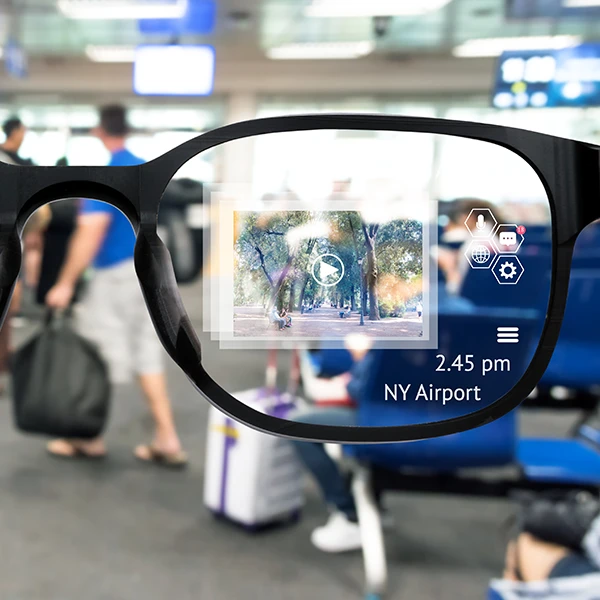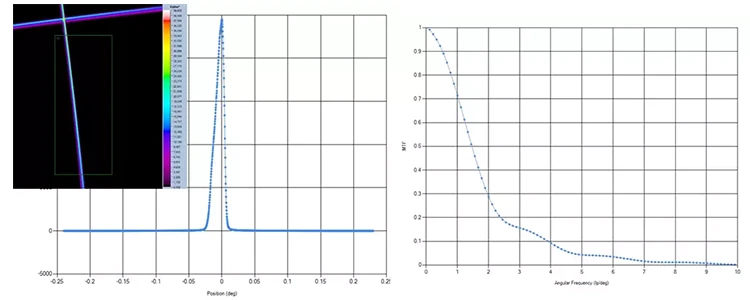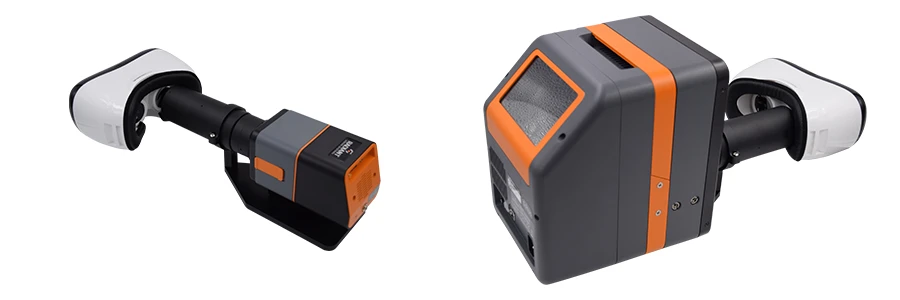ความสำคัญของ MTF (ฟังก์ชันการถ่ายโอนการมอดูเลต) ในการทดสอบจอแสดงผล AR/VR/MR

เทคโนโลยีความเป็นส่งเสริมเสมือนจริง (AR), ความเป็นจริงเสมือน (VR) และความเป็นจริงผสม (MR) ที่พัฒนาอย่างรวดเร็วจำเป็นต้องมีวิธีการทดสอบเฉพาะทางที่แตกต่างจากจอแสดงผลแบบธรรมดาในรูปแบบแสงเรขาคณิต ซึ่งมีปัจจัยสำคัญหลายประการที่ต้องพิจารณาเมื่อมีการประเมินผล จอ AR/VR/MR เช่น ขอบเขตการมองเห็น (FOV) และปัญหาต่างๆ เช่น ภาพซ้อน การบิดเบี้ยว ฯลฯ ปัจจัยสำคัญอย่างหนึ่งที่ต้องพิจารณาเมื่อทดสอบจอแสดงผล AR/VR/MR คือการมอดูเลต ฟังก์ชั่นการถ่ายโอน (MTF) MTF เป็นการวัดเชิงปริมาณที่ใช้ในการประเมินคุณภาพการถ่ายภาพของเลนส์ เช่น เลนส์ เลนส์ AR/VR ฯลฯ ในแง่ของความละเอียดและคอนทราสต์
MTF เป็นการวัดความสามารถของระบบมาตรวิทยาของจอแสดงผล
ในบริบทของระบบมาตรวิทยาการแสดงผล MTF อธิบายถึงความสามารถของเลนส์ของระบบในการถ่ายโอนคอนทราสต์จากวัตถุไปยังรูปภาพด้วยความละเอียดที่กำหนด MTF เป็นหนึ่งในการวัดที่ใช้กันทั่วไปในการประเมินประสิทธิภาพความละเอียดและคอนทราสต์ของระบบมาตรวิทยาของจอแสดงผล MTF ที่ต่ำหรือต่ำกว่าอาจทำให้เกิดความยากในการพิจารณาว่าประสิทธิภาพที่สังเกตได้นั้นเป็นผลมาจากคุณลักษณะโดยธรรมชาติของอุปกรณ์ที่ทดสอบ (DUT) หรือข้อจำกัดของเลนส์และระบบโดยรวม
MTF เป็นตัววัด AR/VR/MR แสดงคุณภาพเอาต์พุตภาพ
ความคมชัดหรือความชัดเจนของภาพที่ฉายขึ้นอยู่กับความสามารถของจอแสดงผล AR/VR/MR ในการแสดงคอนทราสต์ได้อย่างแม่นยำ ซึ่งมีบทบาทสำคัญในการแยกแยะองค์ประกอบภาพต่างๆ และปรับปรุงคุณภาพของภาพโดยรวม คอนทราสต์เชิงพื้นที่ของจอแสดงผล AR/VR/MR ได้รับการประเมินโดยใช้ MTF เป็นหลัก ซึ่งเกี่ยวข้องกับการประเมินจุดตัดของพื้นที่ภาพที่มืดและสว่างโดยใช้วิธีการต่างๆ เช่น Line pairs (การคำนวณคอนทราสต์ของ Michelson), Slant Edge หรือ Line Spread
การวัดความแตกต่างเชิงพื้นที่ผ่าน MTF โดยใช้วิธีจับคู่เส้นเกี่ยวข้องกับการแสดงเส้นคู่ขนานที่มีความถี่เชิงพื้นที่ที่แตกต่างกัน และการวัดความแตกต่างระหว่างเส้นสว่างและเส้นสีเข้ม การวางแนวของคู่เส้นอาจเป็นแนวนอน แนวตั้ง ฯลฯ และความแตกต่างในการคำนวณโดยใช้สูตรคอนทราสต์ของ Michelson ซึ่งเปรียบเทียบความแตกต่างของความเข้มระหว่างเส้นสว่างและเส้นสีเข้ม
วิธีวัดขอบเอียงเกี่ยวข้องกับการวิเคราะห์โปรไฟล์ขอบของชิ้นงานขอบเอียง เป้าหมายประกอบด้วยการเปลี่ยนผ่านจากบริเวณสว่างไปสู่บริเวณมืดอย่างราบรื่น โดยปกติจะอยู่ในรูปแบบของเส้นเอียงหรือลิ่ม วิธีการนี้ใช้ฟังก์ชันการกระจายขอบเพื่ออธิบายว่าแสงกระจายตัวอย่างไรในช่วงเปลี่ยนผ่านจากสว่างไปเป็นมืด หลังจากการแปลงฟูริเยร์ จะได้กราฟ MTF ซึ่งแสดงถึงความสามารถของจอแสดงผลในการถ่ายโอนคอนทราสต์ที่ความถี่เชิงพื้นที่ต่างๆ
วิธี Line Spread ใช้พิกเซลเส้นเดียวในการวัด Line Spread Function (LSF) โดยตรง แทนที่จะวัดคอนทราสต์ของขอบ วิธีนี้เหมาะอย่างยิ่งเมื่อต้องประเมินการแสดงผลแบบพิกเซล ขึ้นอยู่กับการเปลี่ยนแปลงความถี่ของพิกเซลเรืองแสงบรรทัดเดียว ดังนั้น จึงช่วยขจัดปัญหาความถี่พิกเซลต่อพิกเซลที่เกิดขึ้นระหว่างการประเมินการแสดงผลแบบพิกเซล

ตัวอย่างวิธี MTF Line Spread ได้รับความอนุเคราะห์จาก Radiant Vision Systems, LLC
ระบบการวัดมาตรวิทยาการแสดงผล AR/VR/MR
การวัดที่แม่นยำและคุณสมบัติของจอแสดงผล AR/VR/MRถือเป็นสิ่งสำคัญเพื่อให้แน่ใจว่าภาพมีคุณภาพดีที่สุดและประสบการณ์การใช้งานที่สมจริง และจำเป็นต้องมีระบบการวัดแบบพิเศษ Radiant Vision Systems ในเครือบริษัท Konica Minolta Sensing Group นำเสนอระบบการวัดการแสดงผล AR/VR/MR ซึ่งประกอบด้วยการสร้างภาพ ProMetric®คัลเลอริมิเตอร์–โฟโตมิเตอร์, หนึ่งเลนส์ AR/VR, และซอฟต์แวร์ TrueTestกับโมดูล TT-ARVR™ที่สามารถตอบสนองความต้องการเฉพาะในการประเมินจอแสดงผล AR/VR/MR ระบบการวัดการแสดงผล AR/VR/MR ที่ยืดหยุ่นและเป็นนวัตกรรมใหม่นี้นำเสนอการทดสอบมาตรวิทยาการแสดงผลมาตรฐานสำหรับความสว่าง และความสม่ำเสมอ ข้อบกพร่องของพิกเซล ฯลฯ พร้อมด้วยการทดสอบเฉพาะของ AR/VR/MR เช่น ความชัดเจนของภาพ (MTF) การวัด FOV การบิดเบือนและภาพซ้อนของภาพ ความสม่ำเสมอของโฟกัส ฯลฯ

โฟโตมิเตอร์ด้วยภาพ ProMetric® Y พร้อมเลนส์ AR/VR (ซ้าย) และเครื่องวัดสีด้วยภาพ ProMetric® I พร้อมเลนส์ AR/VR (ขวา) ได้รับความอนุเคราะห์จาก Radiant Vision Systems, LLC
หากท่านสนใจเรียนรู้เพิ่มเติมเกี่ยวกับระบบการวัดการแสดงผล AR/VR/MR หรือต้องการความช่วยเหลือในการค้นหาเครื่องมือและซอฟต์แวร์ที่เหมาะสมสำหรับการทดสอบอุปกรณ์ AR/VR/MR ของคุณ สามารถติดต่อกับทีมงานผู้เชี่ยวชาญของเราเพื่อรับคำปรึกษาฟรี
